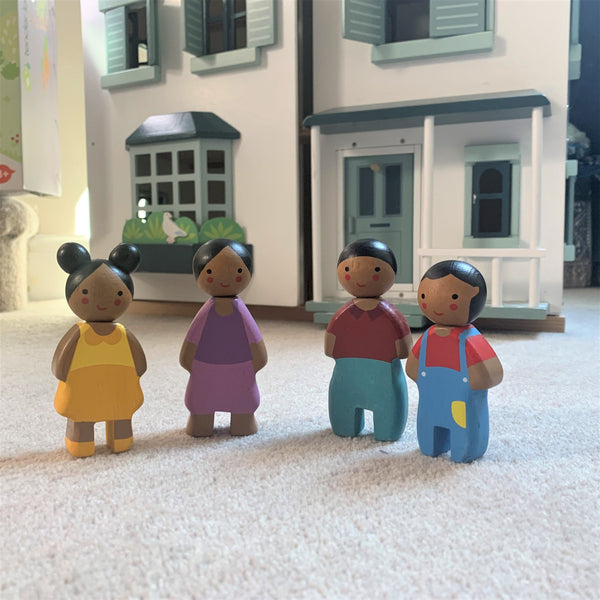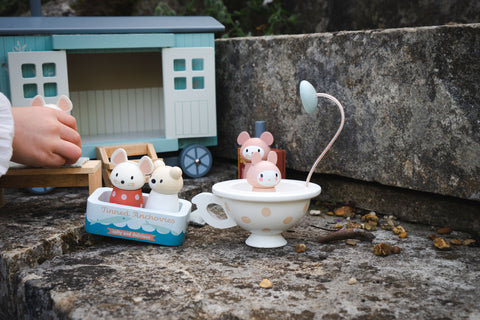Doll's house play | Rehearsing real life

A doll's house is a miniature world.
That sounds trite but for your child it represents her universe.
So much of life happens in the home when you are young. There is no job to go to, no school, no nights out with friends. Home is everything.
This means the doll's house becomes the focus of your play. It's where you go to learn about relationships and rehearse everyday events.
It's also a brilliant tool for teaching spatial reasoning. Where does the furniture go? How will everyone and everything fit in? How do the figures move from one room to the next.
So much to learn!

Your child is in charge
A doll's house is not just a home for tiny figures; it's a canvas for creativity. Here, children are the architects of their own narratives, learning to grapple with life's vast complexities in a world they control.
- It provides a safe space for children to simulate real-life situations and experiment with different scenarios.
- In this petite environment, consequences are understood, and the boundaries of reality can be stretched and molded.
Language development
As children articulate the lives of their miniature inhabitants, they are doing more than playing; they are honing their language skills.
- The act of animating doll's house figures with voice and action lays the foundation for advanced conversational abilities.
- Children echo the adult world, practicing expressions and phrases that they have absorbed from the world around them.
How doll's house play changes with age
Engagement with a doll's house evolves with age, mirroring a child's developmental milestones.
- For toddlers, the doll's house is a treasure chest to be explored. The focus is on sensorimotor exploration. Windows and doors are opened and closed. Figures are posted through windows or moved up and down stairs. The story of the house hasn't yet developed. It's all about the space and what the child can do with it.
- Preschoolers know that there is much more to doll's house play. Their imaginations drive them to tell stories and explore relationships.
What this means is that you can buy a doll's house for a toddler - and she will love it - but don't expect tea parties and sparkling dialogue. That comes with time. But there are many other skills to learn in the meantime.

For boys and girls
Boys love doll's houses too, it's just that the play will be different. More movement, less conversation; more arranging, less relationship-building. But they are still having fun - and still learning. We designed our Dovetail house to be a gender neutral house with cool colours.
Choose the right doll's house
A simple house with a couple of rooms will do fine for most toddlers. At that age, it's all about the physical space and what can be done with it. But as children grow, so does their need for a more interesting house. The features and furniture offer greater opportunities for storytelling.

Two stories are better than one
Rosewood Cottage is the perfect starter home for a toddler (or fairy!). There's a swing and a door - great for a curious two-year-old to investigate.
But preschoolers want more.
Like Max in Where the Wild Things Are, misbehaving characters should be sent to bed without any supper - and that means a bigger house, with two stories and discrete rooms.
You can't be sent to your room unless you have one!

The bigger the better
From a purely story-telling perspective, the more rooms you have, the greater the play potential. A house with a kitchen, living room, bedroom and attic offers more possibilities than a studio flat.
But size isn't everything.
The trick is to have rooms that can be adapted. The pared-back design of Dovetail House gives children the freedom to change how each one is used from one day to the next. The kitchen becomes a bedroom, the living room a knight's armoury.
Larger, more elaborate doll's houses can become the cornerstone of a child's play area, inspiring epic tales and intricate storylines. Fantail Hall

The significance of stairs
In the geography of a doll's house, stairs are more than just functional; they are symbolic.
They represent movement and progression, inviting dolls—and children—to venture through the stories that unfold on each floor.
Looking through windows
A doll's house is a theatre, and its windows and doors are the frame through which stories unfold.
Children are fascinated by different perspectives. They love to lie down and see the action at ground level and they delight in peeping through windows.
How many ways does your doll's house allow you to look inside? What interesting angles does it offer?
The heart of the home
Remember, the essence of a doll's house lies in the dialogue it inspires, not in its physical form.
Spaces like stables or even castles can work just as well as a doll's house for encouraging conversation. Choose the form that appeals the most to your child.

Choose the right furniture
Furniture animates the otherwise empty spaces of a doll's house, imbuing them with purpose and life. Similarly a wooden doll family can represent the members of a family.
A readymade set means your child can get straight down to play but you can add interest and fun by introducing other objects. A shoe for the little old lady to sleep in. A teacup for the mice to nest in.
Encouraging children to customise and create their furniture pieces nurtures a sense of ownership and pride in their play.

Characters of all scales: The diversity of doll's house residents
Inhabitants of a doll's house need not be uniform; they thrive on diversity.
Shows like "Moon and Me" demonstrate that characters of varied scales and styles can coexist, enriching the storytelling experience.
The ever-changing house: Decoration and reinvention
A doll's house is never static; it's a living, changing space that reflects the growth of its owner.
If there comes a time when your child's interest wanes, perhaps a DIY project to wallpaper the rooms might rejuvenate the space.
We have lots of craft orientated free printables to try out and many of them have been designed to accompany our dolls houses.

Final word
In conclusion, the doll's house is a microcosm of the world—a teaching tool, a friend, and a story-generator all in one. It is a place where imagination knows no bounds, and every room holds the potential for learning, discovery, and wonder.






